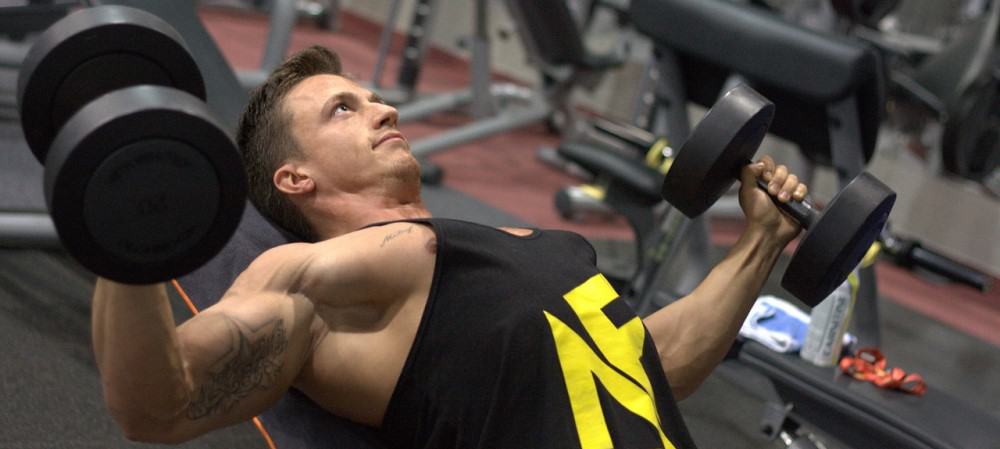HST means Hypertrophy Specific Training and emerged from research in the field of muscle cell stimulation and the mechanisms of cell hypertrophy.
Therefore, it can be said that the HST system is based on the principles of hypertrophy.
These “principles” have been organized into a kind of “method” aimed at stressing the muscles with a mechanical weight to induce hypertrophy.
It goes without saying that summarizing the principles into applicable methods (such as sets and reps in the form of training plans) also leaves a certain scope for misperceptions.
However, one can assume that with increasing research and know-how, the understanding of muscle hypertrophy will increase and mistakes will be eradicated over time.
Bryan Haycock is considered the “inventor” of modern HST training. Although the principles were used much earlier in weightlifting, Haycock has brought these into an understandable structure and established new rules.
In setting up his system, he has included all the latest scientific studies to be up to date.
HST Training at one glance:
- Goal: Muscle growth and strength
- Training split: Full body
- Training level: Beginners/advanced/professionals
- Frequency: 3-6 times per week
HST Training System Concept
All training system have their own special features. In HST, each muscle is trained several times a week with high volume (at least 3 times), where muscle failure is completely omitted.
This makes HST the ideal choice for people who do not have a regular training partner or who try to avoid being dependent on other people.
There are two different HST variations:
- 1) Classic HST
- 2) Cluster HST
Overall, four important terms can be identified through the whole system and these I would like to explain first.
1. Mechanical load: For a muscle to grow, it must be loaded against the highest possible resistance. This happens, as you can imagine, by the use of weights.
Thus, for HST training it is necessary to train with weights!
2. Frequent training load: Since many of the processes triggered by mechanical stress such as protein synthesis (MPS) or IGF-1 after max. 48 hours these processes are back to the starting level, it is most effective to train the same muscle after 48 hours the latest.
So, training frequency also plays a major role in muscle hypertrophy.
3. Progressive weight increase: The most important aspect in any training system, and the deciding factor of whether a system works or not is progress.
Obviously it is impossible to progress in every workout, or even every month, but in the long run you should make accountable progress.
The body tissue adapts to the actual training weight, which can already happen after 48 hours. Although metabolic adjustments take longer, muscle growth can come to a stillstand relatively quickly. Therefore, it is necessary to regularly increase the weights (mechanical load).
Therefore, try to train progress as consistent as possible!
4. Strategic deconditioning: Since it is not possible to increase the weights endlessly, there is the so-called strategic deconditioning in the HST system.
As soon as you reach your limits, the point where you’re not able to make further progress, you are at a point where the body no longer reacts with growth.
Now it’s time to take a break from training and work your way back to your personal bests. In addition, the deconditioning also has the positive effect that in this time overtraining symptoms or minor injuries can be cured.
Lastly, as important training is, as important are breaks every now and then.
The following rules apply to both the classic HST and cluster HST:
- Training weight must always be increased or at least kept constant. Never lower the training weight.
- If the weight is too high then reduce the number of total reps but do not lower the weight
- Each muscle is trained at least 3 times a week
- Obey scheduled rest days
Classic HST
In classical HST, a macrocycle takes 6-8 weeks and is subdivided into 3 microcycles. It also includes a maximum strength test and the deconditioning phase (deload phase).

- 1st microcycle (2 weeks): 15 reps 2 sets
- 2nd microcycle (2 weeks): 10 reps 3 sets
- 3rd microcycle (2 weeks): 5 reps 4 sets
Each microcycle lasts about 2 weeks and the weight is increased steadily in each session.
Since every muscle has to be trained at least 3 times a week, it is useful to either conduct a full body plan or maybe a split.
After you’ve reached your personal maximum at the 15 reps, the number of reps will be reduced down to 10 reps and the weight raised.
With this in mind, as soon as you reached the maximum weight with 10 reps, lower reps down to 5 and add weight respectively.
Lastly, once you reached the maximum with 5 reps, it follows the deconditioning (deload phase) phase for 7-10 days. This is basically a ‘deload phase‘.
What is a so-called deload phasehttps://emerging-athlete.com/what-are-deloads-and-how-do-they-work/? If you want to know more, check out the link to read my whole article about deloads.
Then the whole thing starts over again.
Cluster HST
Basically, the idea of a scheme with fixed sets and reps falls largely away. In this concept the focus is concentrated more on reps and weight.
Sets (here called clusters) often only contain 5, 3 or just 1 rep. However, the overall rep number is around 20-30 reps.
At the end of a macrocycle, it is not uncommon seeing 30 reps scheduled in your program…
Since this is a very heavy burden on the body, especially joints and tendons, such a program should only consist of between 3-6 exercises.
In order to keep the break times short enough, 2-3 exercises are usually performed successively.
For example, 3 reps of pull-ups alternating with 3 reps of dips until you have achieved the total reps for both exercises.
The rules that apply to HST classic training, as well as the deconditioning, are just as valid here.
All in all, cluster HST is more tailored to advanced athletes. You should already be gone through a few classic cycles before starting the cluster.
For whom is HST suitable?
Although training on the basis of the HST method sounds appealing to beginners, it is most suitable for advanced athletes in bodybuilding.
Having some routine in choosing the right workout weight and training without muscle failure is particularly important in achieving the desired outcomes, therefore a certain amount of training experience is preferred.
As you may notice, almost every training system that I am presenting here seems to be for more advanced athletes.
Well, somehow yes. If you think about it, it makes sense. Beginners benefit from even the smallest stimuli. Whether this is one set or 5 sets. If you’ve never worked out before, then your muscles will grow from every single rep.
With this in mind, although it sounds boring and reluctant, stay with the basics in the beginning.
That basic program will already provide great muscle growth and strength improvement.
Programs just as HST or FST-7 are designated for people who’ve already trained for some time and now facing plateaus or became bored with their routine.
Of course, you should and do not have to train with the same basic plans for years, certainly not. But I can really recommend using your potential as efficiently as possible.
HST Training Advantage
HST, as a science-based training method, relies on a moderate pathway to achieve optimal training results. Therefore, the focus is a targeted use of training stimuli without too much emphasis on individual training parameters.
In particular, the training method focuses on putting on training stimuli if and only if the muscle is receptive to them.
Excessive stress on the nervous system (CNS) is deliberately avoided in order to prevent superfluous long regeneration times.
This makes it possible to precisely schedule when training stimuli bring the optimal results.
It can, therefore, be said that the advantage of HST lies in the scientifically based and strategically sensible use of training incentives and stressful, counterproductive factors are minimized as much as possible.
Thus, creating a highly effective training along the lines of “pure muscle building”.
HST makes the difference
Over-accentuation
HST deliberately refrains from emphasizing one of these training aspects too much. The reason for this is that such over-accentuation can adversely affect the required regeneration time.

Following this idea of effectiveness, HST clearly offsets against other training methods for building muscle.
After all, unlike other training methods, not just one training aspect should come to the fore here.
For volume training, a high amount of reps and sets can be found in the foreground. In high-intensity training systems, however, it should be trained as often as possible to muscle failure.
48-hour rule
Since different training aspects are in focus of various training methods, the time required for regeneration between this method also varies accordingly.
While volume training and high-intensity systems usually take more than 48 hours of regeneration time, in high-frequency training its most likely less.
Long regeneration times of more than 48 hours are necessary, especially when the nervous system has been strained enormously due to immense volume or training beyond muscle failure.
In high-frequency training, however, muscle failure is omitted while still having 5-7 sessions per week. As a result, the regeneration times here are way shorter than 48 hours.
In contrast, the HST method assumes that muscle building takes place after a workout for only 48 hours, no matter how high volume or intensity was previously.
Optimal regeneration leads to optimal muscle growth
HST training is based on the just mentioned 48-hour rule.
Training to failure or extreme volume is omitted so as not to unnecessarily burden the nervous system (CNS).
Finally, the regeneration time is not required for muscle growth but for the recovery of our nervous system.
With regeneration times that are less than 48 hours, heavy workload becomes too frequent. Meaning, before the muscle has recovered from the last training session and this can lead to overtraining.
That’s why the HST requires 48 hours of rest between each training session. So the muscle should receive growth stimuli if and only if it is receptive to it.
In addition, too long regeneration times, which are necessary due to an extreme load on the nervous system, should be avoided.
HST Sample Workout
HST splits your training into an 8-week cycle. The training weight is steadily increased, but with decreasing reps respectively.
All in all, you will complete a full body workout 3 days per week and maintain a recovery timeframe of 48 hours between each training session.
For each exercise, choose a weight that allows you to master the appropriate number of reps, but without getting to muscle failure.
As a rule of thumb for weight increase per session, you can use the following benchmarks:
- Upper body 3-5%
- Lower body 5-10%
Since everybody is individual, these aren’t applicable to all of you. Use them as landmarks and keep them up as good as you can, if that seems not possible, lower the rates.
HST cycle:
- Week 1: 15 reps
- Week 2: 12 reps
- Week 3: 10 reps
- Week 4: 8 reps
- Week 5: 6 reps
- Week 6,7,8: 5 reps
Similarly, in week 1, you perform each exercise with weights that will allow you to do 15 reps without going to muscle failure.
In week 2, the same principle follows but with 12 reps instead of 15 reps.
This means you increase the weight as much as you reached the point where you can execute 12 proper reps without muscle failure.
As you have reached a relatively high training weight in week 6, you can keep it for 3 weeks.
This is because your body gets used to the increased muscle tension more slowly.
An HST training plan might look like the following:
- 1 set lat pulldowns
- 1 set close grip cable rows
- 1 set deadlifts
- 1 set squats
- 1 set leg extensions
- 1 set leg curls (hamstrings)
- 1 set bench press
- 1 set cable flys
- 1 set military press
- 1 set lateral raises
- 1 set butterfly reverse
- 1 set shrugs
- 1 set calves raise
- 1 set biceps curls
- 1 set hammer curls
- 1 set dips
- 1 set triceps pushdowns
- 1 set machine crunches
Wow, this looks like hell a lot of stuff… Right?
Yeah, it surely does, but as the saying does: no pain no gain;)
How are you supposed to get all this done in one training session without spending the whole day in the gym?
Here’s the point.
Most importantly, you perform only ONE SET per exercise.
Furthermore, not reaching muscle failure also saves some time because of reduced recovery time between the sets.
The number of reps and weight depends on the current training week, as shown above.
When the week 8 cycle is completed, it follows a break of 9 to 14 days. This is either a so-called ‘deconditioning‘ or ‘deload‘ phase.
Basically, these rest phases are meant to ensure proper regeneration for our muscles and the nervous system so that we can continue to stimulate growth after the break.
Final thoughts: HST Training System
To conclude, the HST training provides another great method to stimulate muscle growth.
As it is with all training methods, they all have their own and often just slightly altered system.
Nevertheless, they all have their own reason to exist with different approaches and focusses.
This program offers a time-efficient approach for all among yourselves who want to build muscle but either do not have or do not want to dedicate too much time to it.
Full body workout with 3 sessions per week is definitely feasible for all of you, whether student, full-time employed or diligent businessmen.
At the end of the day, it’s your life. If you don’t want to put in that effort, time and research, then don’t.
I don’t mind, you make the call. But please stop complaining and get used to it.
You have everything you need to change your life the way you want.
And that’s our vision. We want to help you to reach your whether athletic, mindfulness or performance oriented goals.
We can only show and present you approved systems, approaches and ways how it CAN be done. There is no ‘sample solution’ for everything.
Read our advice carefully and think about it.
Does it align with your values and goals? What might not match your current situation?
Then take small pieces of all the systems, approaches and hints and tailor your own unique system.
What do you think about the HST training? Did you already try it? Did you achieve the desired results?
Share your experiences with us in the comments below!
Thanks for your attention guys,
Claas




